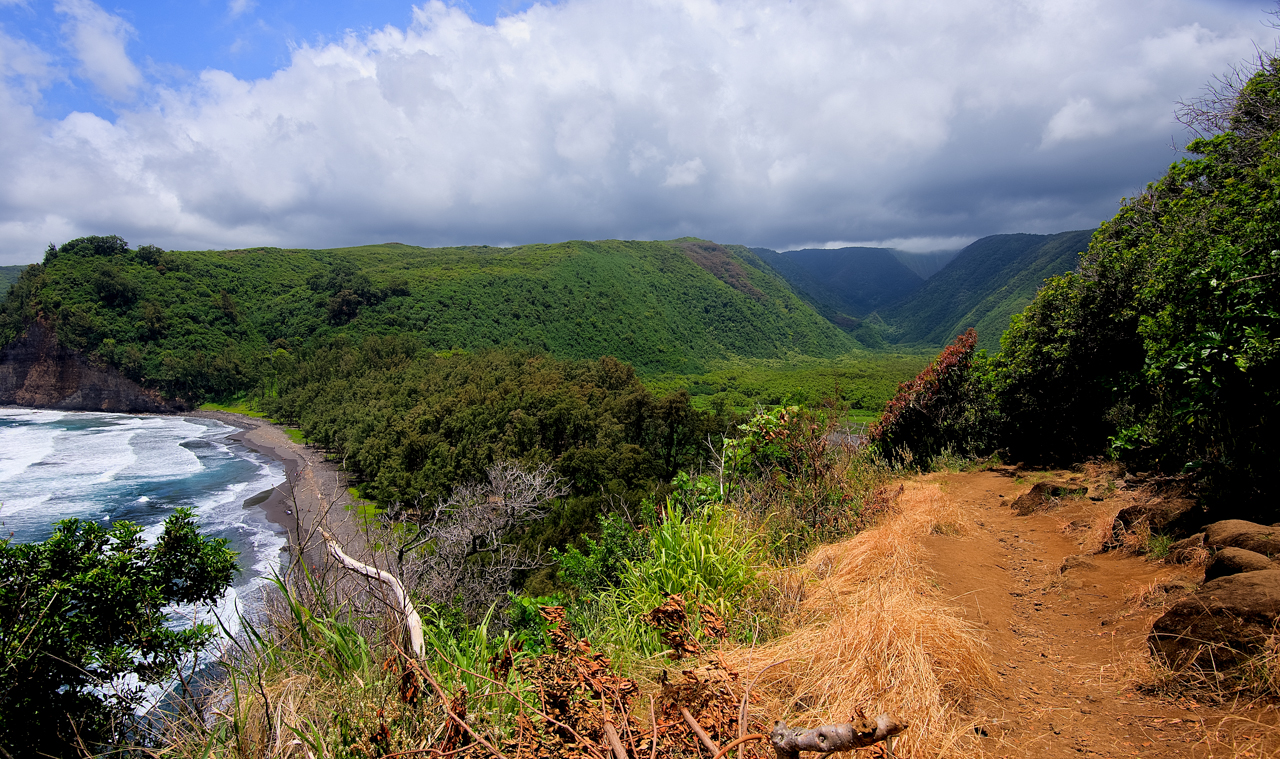Pololu Valley
Big Island’s North Koala Region offers numerous gems for a curious traveler. This side of the island is rugged and wild, where enormous cliffs and picturesque valleys carpeted in lush vegetation abound. Pololū Valley lays on the northernmost point in series of erosional valleys and it’s one of only few reachable on foot.
North Kohala was built of lava flowing from Big Island’s oldest volcano, the extinct Kohala. Being the youngest in the chain, island of Hawai’i coast is different than older islands like Kauai and Oahu. However, Pololu Valley offers a glimpse into geological processes that shaped these other Hawaiian islands to the topography they have nowadays. While not as dramatic as Kauai’s Na Pali Coast, wind, rain and ocean waves eroded softer lava rock forming V shaped valleys with high and very steep cliffs. The process will continue until the ocean swallows Big Island, ultimately winning the battle that started when the island first lava rock reached the surface. No worries though, we still have few million years to enjoy Hawai’i before it fulfills its destiny.
Pololu Valley, now uninhabited, have a rich history of taro and rice growing. Hawaiians also hauled weatherworn lava rocks up the hill to build temples and other religious structures. Today, it is open for tourists and locals alike, but the back of the valley is still in private hands and should be avoided (there is no clear path going inland while at the valley floor anyway)
Whichever directions you are coming from, there’s only one road leading to Pololu Valley-Highway 270- and the overlook is located at the very end of it. Plan to leave early, as the parking area around the overlook is quite small. Besides that, the drive to Pololu Valley through North Koala region can be considered a journey on its own. Coming from Kona side we passed by some amazing lava fields that suddenly gave away to lush green hills and eventually to more tropical foliage as we get closer to the valley. Additionally, Highway 270 crosses North Kohala’s largest settlement, a little town of Hawi.
This picturesque place used to be home for sugar cane plantation workers. The company closed its doors in the 70’s, significantly affecting local economy and forcing people to move elsewhere. Fortunately, few brave residents decided to stay and rebuilt Hawi former glory. They’ve transformed the town from its plantation past to a charming tourist attraction it is today. Hawi is home to few restaurants, galleries and boutiques selling locally made souvenirs. We stopped at local pastry store and ate the most delicious ice cream ever (toasted macadamia nut flavor, don’t miss this sweet opportunity to get extra calories :).
Closer to the valley on Highway 270 lays a village of Kapa’au that serves as a replenish point before getting to the parking lot. Follow the road to a fork in the end, on the left-hand side you’ll see signs for Pololu Valley. Take that turn and after few hundred feet the road ends with a parking area. You can also park alongside the road if parking’s full.
Our visit to Pololu Valley
The view from Pololu Valley parking lot is simply breathtaking- enormous, extremely steep cliffs blanketed in tropical vegetation “guarding” a valley below. On one end, evergreen mountains cut the valley from the rest of the island, while on the other, powerful waves break and slip down a black sand beach. As beautiful as it is, the view from atop reveals only a small portion of what Pololu Valley has to offer. The overlook is a starting point for Awini trail that leads down to the valley floor and beyond (more on that later). The distance to the beach is approximately 0.4 miles (0.6km) and it takes between 15-25 minutes to get there. Right at the beginning of Awini trail, there is a post with signs warning you about possible dangers along the way.
The downhill hike is quite difficult, with steep path and uneven dirt surface that can turn into a muddy stream when it rains heavily (although some local folks told us that while it rains often at this location, rain clouds usually go away after few minutes).
We’ve seen people descending in flip-flops (that must have been painful), nevertheless we recommend good hiking sandals with closed toe for this one. One additional thing- there’s a chance of landslide (which you can’t predict anyway, so count on good luck) and the ocean below is violent and un-swimmable (that’s a fact, when we visited the power of waves was impressive to look at). The stream that cuts through the middle of Pololu Valley may turn into rapid river after heavy rainfall, so use your judgment when attempting to cross it (it was dry at the head when we were there).
Right after finishing our descent to the valley floor, we continued towards the beach, passing through tropical jungle and magnificent ironwood trees right by the shoreline. This idyllic setting is a perfect spot for picnic and sunbathing. If you’re hungry for more wandering (and we hope you are), the trail continues alongside the beach to the other side of Pololu Valley and up the cliff for another 1.1 mile (1.8 km) to the next one in chain- Honokane Nui Valley. You’ll be crossing some fantastic looking low, fern-like foliage (look at the picture below) that resemble nothing but an underwater aquascape you can see in planted aquariums (if you’re a fishkeeping aficionado like me we’re on the same page) that morphs into a narrow, often overgrown path through tropical jungle.
About ¾ of the way up we bumped into a horse gate. From here the scenery changes to dried shrubs and hay colored grass. After few hundred feet, an overlook for Honokane Nui reveals itself with its full beauty. There’s a small bench to sit and breathe in the view (there’s a good chance you’ll have it all for yourself). Honokae Nui Valley, when seen from above, seems even more remote and beautiful. We strongly suggest spending some time at the overlook just to enjoy the view and cool breeze coming from somewhere thousands of miles afar. Unfortunately, Awini trail ends at Honokae Nui Valley overlook. It used to lead to the valley floor, but an earthquake in 2006 resulted in a landslide that destroyed the footpath. Come back to the parking lot the same way you came and remember to allow yourself some extra time as hiking back uphill requires some more elbow grease to finish.
Pololu Valley, the town of Hawi, as well as entire North Koala region are worth a day (or better two) of your time and offer scenery you won’t find anywhere else in the state. Enjoy it yourself and share some experience by leaving comments!
Pololu Valley Gallery






















